Computer Vision - ECCV '94
Evolutionary fronts for topology-independent shape modeling and recovery.- Epipolar fields on surfaces.- Stability and likelihood of views of three dimensional objects.- Topological reconstruction of a smooth manifold-solid from its occluding contour.- Optical flow estimation: Advances and comparisons.- Multiple constraints for optical flow.- Motion field of curves: Applications.- Sufficient image structure for 3-D motion and shape estimation.- A comparison between the standard Hough Transform and the Mahalanobis distance Hough Transform.- Junction classification by multiple orientation detection.- Following corners on curves and surfaces in the scale space.- Scale-space properties of quadratic edge detectors.- A scalar function formulation for optical flow.- First order optic flow from log-polar sampled images.- Recursive non-linear estimation of discontinuous flow fields.- The use of optical flow for the autonomous navigation.- An image motion estimation technique based on a combinedstatistical test and spatiotemporal generalised likelihood ratio approach.- Independent motion segmentation and collision prediction for road vehicles.- An MRF based motion detection algorithm implemented on analog resistive network.- Occlusion ambiguities in motion.- A robust tracking of 3D motion.- Robust multiple car tracking with occlusion reasoning.- Shape from motion algorithms: A comparative analysis of scaled orthography and perspective.- Robust egomotion estimation from affine motion parallax.- Integrated 3D analysis of flight image sequences.- Recursive affine structure and motion from image sequences.- Shape models from image sequences.- Vibration modes for nonrigid motion analysis in 3D images.- Applying VC-dimension analysis to object recognition.- Extraction of groups for recognition.- Model based pose estimation of articulated and constrained objects.- Seeing behind occlusions.- Face recognition: The problem of compensating for changes in illumination direction.- Learning flexible models from image sequences.- A direct recovery of superquadric models in range images using recover-and-select paradigm.- Segmentation and recovery of SHGCs from a real intensity image.- Recognizing hand gestures.- Pose refinement of active models using forces in 3D.- Recovering surface curvature and orientation from texture distortion: A least squares algorithm and sensitivity analysis.- Direct estimation of local surface shape in a fixating binocular vision system.- Deriving orientation cues from stereo images.- Shape-adapted smoothing in estimation of 3-D depth cues from affine distortions of local 2-D brightness structure.- Utilizing symmetry in the reconstruction of three-dimensional shape from noisy images.- Consistency and correction of line-drawings, obtained by projections of piecewise planar objects.- On the enumerative geometry of aspect graphs.- Geometry-driven curve evolution.- Quantitative measurement of manufactured diamond shape.- Hierarchical shape representation using locally adaptive finite elements.- Camera calibration from spheres images.- Self calibration of a stereo head mounted onto a robot arm.- Analytical methods for uncalibrated stereo and motion reconstruction.- Self-calibration from multiple views with a rotating camera.- Trilinearity in visual recognition by alignment.- What can two images tell us about a third one?.- A robust method for road sign detection and recognition.- Pose determination and recognition of vehicles in traffic scenes.- Performance comparison of ten variations on the interpretation-tree matching algorithm.- Recognition of human facial expressions without feature extraction.- Pulsed neural networks and perceptive grouping.- Projective invariants for planar contour recognition.- Divided we fall: Resolving occlusions using causal reasoning.- Camera calibration of a head-eye system for active vision.- Linear pushbroom cameras.- Robust recovery of the epipolar geometry for an uncalibrated stereo rig.- A stabi
| Erscheint lt. Verlag | 20.4.1994 |
|---|---|
| Reihe/Serie | Lecture Notes in Computer Science |
| Zusatzinfo | VIII, 620 p. |
| Verlagsort | Berlin |
| Sprache | englisch |
| Maße | 155 x 235 mm |
| Gewicht | 763 g |
| Themenwelt | Informatik ► Grafik / Design ► Digitale Bildverarbeitung |
| Mathematik / Informatik ► Informatik ► Software Entwicklung | |
| Informatik ► Theorie / Studium ► Künstliche Intelligenz / Robotik | |
| Schlagworte | Bewegungsanalyse • Bildverarbeitung • Computeranimation • Computergraphik • computer vision • Computervision • Epipolar Geometry • Hardcover, Softcover / Informatik, EDV/Informatik • HC/Informatik, EDV/Anwendungs-Software • HC/Informatik, EDV/Informatik • Hough Transform • Image Processing • Mustererkennung • Object recognition • optical flow • pattern recognition |
| ISBN-13 | 9783540579564 / 9783540579564 |
| Zustand | Neuware |
| Informationen gemäß Produktsicherheitsverordnung (GPSR) | |
| Haben Sie eine Frage zum Produkt? |
aus dem Bereich




